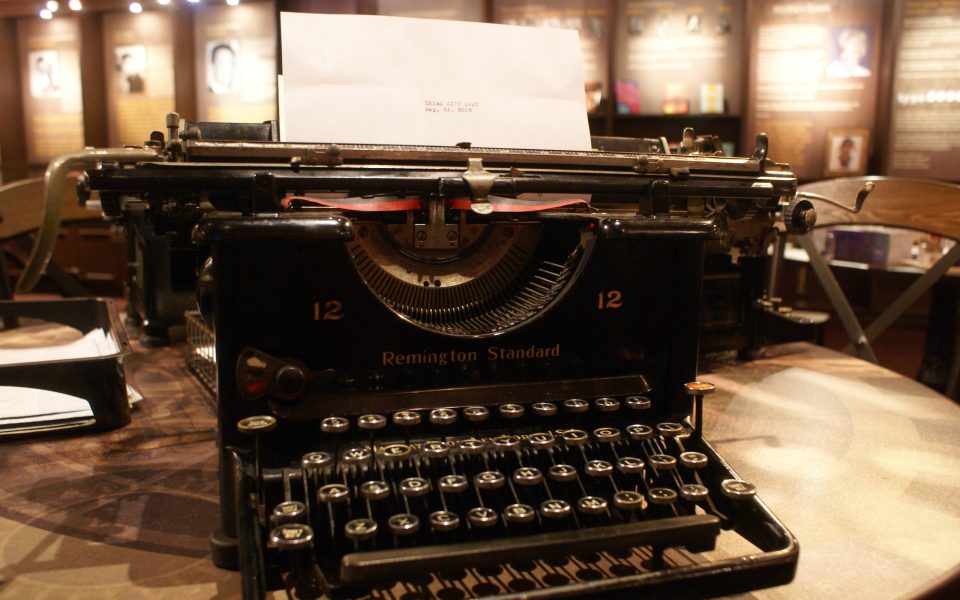In 1971, Truman Capote could have bought any typewriter he wanted.
This was five years after the publication of In Cold Blood, his seminal nonfiction novel, and 10 years after the film version of Breakfast at Tiffany’s made him a rich man. Capote says he wrote both of these manuscripts by hand, in pencil. Yet for his typing he chose the Smith-Corona Electra 110, a sturdy workhorse that merged the best features of the old iron manuals and the dawning computer age.
Ernest Hemingway preferred to write by hand, too, though he used a typewriter to write dialogue, usually standing. His 1929 manual Underwood Standard, surprisingly small against the author’s outsized legacy, must have proved up to the task.
They’re both part of the collection of Steve Soboroff, the current president of the Los Angeles Police Commission and onetime mayoral candidate for that city, who has been gathering them since 1999. Some of his most prized typewriters are on display at the Greensboro History Museum through Aug. 19.
One of Maya Angelou’s typewriter is here, also under glass: an electric Adler that still bears a sticker from Executive Business Machines, back when Winston-Salem had a 910 area code.

©
Here is Tennessee Williams’ 1936 Corona, upon which he wrote his first plays at Washington University in St. Louis. There is George Bernard Shaw’s 1934 Remington, through which he channeled his last five plays. Gore Vidal’s Smith-Corona. John Lennon’s 1951 Imperial, the one he used to write all the songs for the Quarrymen, the predecessor to the Beatles. Ray Bradbury’s manual Royal, dated to 1947, is here as well, though Bradbury wrote all of his early stories, including Fahrenheit 451, in the basement of a building at UCLA, on typewriters he rented for a dime an hour.
O. Henry’s typewriter, a 1912 portable Corona small enough to fit in a handbag, makes the rest of them look fairly high-tech.
Before the cloud, before the internet, before the hard drive, the floppy and before the personal computer and its forebear, the “word processor,” the typewriter was a revolution in 47 keys, a standardized writing platform that enabled the user to get words on paper at a much faster rate. The purists eschewed it from the beginning, in much the same way photorealistic painters disavowed the camera when it came on the scene. They said the typewriter disrupted the natural flow between mind and hand and pen and paper.
But it upped word count from about 25 a minute — which even the fastest scribbler can barely exceed — to twice that and, as the years and technology wore on, exponentially faster: The current world record holder, Barbara Blackburn, maintains a rate of 150-212 words a minute.
Museumgoers can try their hands at an array of vintage machines, both manual and electric, arrayed on tables in the second half of the exhibit.
An old manual Underwood demands strict intervals between keystrokes lest they become jammed in the carriage. An IBM Selectric thunders like machine-gun fire when it gets going. An elegant electric Smith-Corona emits a gentle ding when it’s time to hit the hard return.
[pullquote]type-WRITE: Typewriters from the Soboroff Collection at the Greensboro History Museum through Aug. 19. More: greensboroyhistory.org[/pullquote]
These dings and clacks… a typewriter demands the user’s attention not just to every word but to every letter as it’s thrown onto the page, attuned to the hard margins and the satisfying thwack and scroll of the return bar. Stacks of paper. Ribbons of ink. An edit means retyping the entire thing all over again. And at any given time, there’s only a single copy of the current work.
Truman Capote wrote his last three books on the Smith-Corona Electra 110, as well as hundreds of pieces of correspondence before he died in 1984.
His personal letters, though, he still wrote by hand.
Join the First Amendment Society, a membership that goes directly to funding TCB‘s newsroom.
We believe that reporting can save the world.
The TCB First Amendment Society recognizes the vital role of a free, unfettered press with a bundling of local experiences designed to build community, and unique engagements with our newsroom that will help you understand, and shape, local journalism’s critical role in uplifting the people in our cities.
All revenue goes directly into the newsroom as reporters’ salaries and freelance commissions.


Leave a Reply